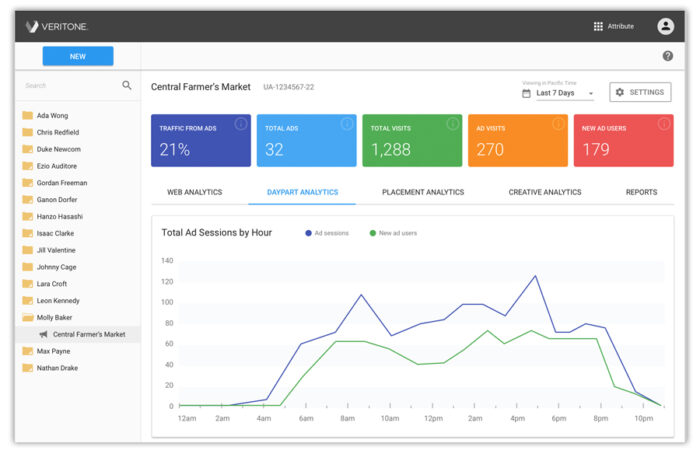Solution Brief
Intelligent, Real-Time Media Attribution for TV and Radio Broadcasters
Prove and enhance the effectiveness of broadcast advertising to drive customer investment with Veritone AttributeTM
BROADCAST AD ATTRIBUTION IN THE INTERNET AGE
In an information age dominated by the Internet, television and radio broadcasters face medium-centric disadvantages in competing for advertising budgets. Unlike their digital counterparts, they lack the instruments to track online impact from broadcast advertising campaigns with enough precision to quantifiably measure the efficacy of ad placements. This inability to correlate advertisements with online results, a process known as attribution, prevents broadcasters from gathering the evidence needed to demonstrate the value of their broadcast channel for consumer activation to their customers—and to shift advertising budgets away from digital rivals. However, new artificial intelligence (AI) technologies can reveal when and how radio and TV advertising drives consumers’ online purchasing activities, providing broadcasters with a powerful attribution tool to prove and grow the impact broadcast advertising has on their customer’s business. This brief lays out how Veritone Attribute, an AI-powered media attribution solution, empowers broadcasters to demonstrate advertising efficacy in near real-time to their advertising customers, elevating broadcast media measurement to new levels of precision so broadcasters may compete with online media channels to claim advertising budgets.Today's Challenges
Attribution is a widespread challenge. When considering attribution, a recent survey of marketing professionals identified optimization of marketing program spend across multiple media channels as their top concern, as contemporary technology to date has restricted their ability to carry out attribution properly.1
Attribution is particularly troublesome in the broadcast realm. At times, TV and radio networks are unable to substantiate whether an advertisement was trafficked. Even broadcasters that are more effective at managing media clearance often are relegated to manual review workflows to track increasingly popular native advertisements and organic mentions that are not reflected in programming logs, requiring enormous investments in time and human labor to review broadcasts and pinpoint ad delivery.
This lack of comprehensive tracking makes it difficult to determine the effectiveness of advertising. When directing audiences to online destinations, broadcast campaigns often prompt consumers to enter promotion codes at checkout as a tracking mechanism for campaign activation, but often provide incomplete attribution data when consumers fail to enter promo codes or delay purchase.
Contemporary technology to date has restricted (marketing professionals’) ability to carry out attribution properly.
Lacking precise data about ad appearances and a system for tracking responses to online calls-to-action, advertisers are left with insufficient broadcast attribution data. As a result of this insufficient data, it is difficult for broadcasters to demonstrate the value of advertising campaigns during contract negotiations when attempting to sustain, let alone increase the ad spend of their customers.
Solution
The introduction of AI-based services into traditional media attribution workflows has become a game-changer. AI can augment human capabilities by reviewing content and extracting key insights, such as the difference between an ad and in-program chatter, faster and more consistently than manual operations. Using AI, sales operation teams can validate ad delivery within programming for both pre-recorded and native advertising types systematically, accelerating their reporting workflows.
Accelerating ad verification and enabling media attribution with AI
For broadcast audio content, this detection is accomplished through AI transcription and audio fingerprinting capabilities, enabling broadcasters to employ new techniques like listening for keywords in the recording, such as a sponsor’s name, or for an exact audio clip that matches the advertisement creative.
For TV broadcasters’ video-based content, AI employs technology that watches the programming to locate a product or brand placed visually as part of a sponsor’s campaign. This includes capabilities such as logo, object and face recognition as well as optical character recognition (OCR) which can read text found on the screen. These tools have proven to be extremely beneficial, picking up the logo or object, pulling related text from video frames or recognizing specific actors.
Furthermore, AI-based audio and ad fingerprinting can help broadcasters identify audio or creative signatures across multiple media file types and assist with the categorization of ads, classifying them as native spots or pre-produced campaigns.
The faster review and ad detection capabilities of AI augment manual workflows, reducing cost and improving the overall efficacy of operations. Moreover, these enhanced capabilities empower sales teams with the exhaustive ad verification data required to correlate against web analytics for accurate campaign optimization and ad efficacy reporting within their broadcasts.
HOW IT WORKS: Harnessing AI to optimize and communicate the impact of broadcast advertising
A new solution tailored for broadcasters allows sales representatives to minimize manual ad verification processes and quickly assess, optimize and communicate the impact of their advertisers’ campaigns. This is accomplished through the use of AI technology to automatically identify pre-recorded ads, live reads and organic mentions in playout logs and live broadcast programming supported by a robust media attribution analytics dashboard.

Veritone Attribute enables broadcasters to quickly compare ad delivery and mentions to an advertiser’s website analytics, establishing a path to broadcast media attribution for website traffic and purchases. Sales representatives can monitor an individual customer’s attribution analytics in a near real-time dashboard of top level summary metrics as well as detailed web, daypart, placement and creative analytics. This level of analysis allows sales teams to empirically demonstrate ROI and optimize campaigns through multivariate testing for greater effectiveness in activating their advertisers’ desired target audiences. Additionally, data-driven dashboards can be shared with clients with minimal preparation in the form of auto-generated, branded PDF and interactive PowerPoint reports.
The solution enables broadcast sales and campaign managers to track near real-time analytics for not one but all advertisers they manage in their portfolio, while making the onboarding process quick and easy for their advertisers. For each advertiser, the campaign manager is guided through a simple, three-step new advertiser setup entailing the advertiser’s details, selecting the appropriate ad types by member station or channel, and inviting the advertiser to connect their Google Analytics account to Veritone Attribute via an automated email workflow. Broadcasters have the option to configure the ad types analyzed for each advertiser between pre-recorded spots, live reads and organic mentions tracked with intelligent watchlists triggered by keyword, audio and ad fingerprints, logos, objects and faces detected in live broadcast programming. With permission from the advertiser, Veritone Attribute is given limited, read and analyze access only for the Google Analytics account property and view they choose. Once the onboarding process is complete and Google Analytics connected, the new advertiser’s attribution analytics dashboard populates in seconds to minutes to quick start campaign optimization and attribution reporting on an advertiser by advertiser basis.
